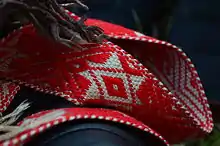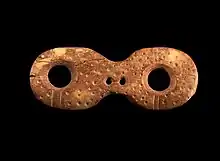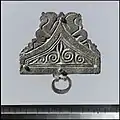Belt (clothing)
A belt is a flexible band or strap, typically made of leather or heavy cloth and worn around the waist or above the hips, that is usually of less circumference than the hips underneath. Belts are used to secure or hold up clothing, like trousers or other articles of clothing, in a manner similar to suspenders and garters. Some trousers come with belt loops around the waist, which the belt goes through. Belts can have many uses, but they are often used as a fashion accessory, with many colours, styles, and finishes. In heavy metal subculture, bullet belts and studded belts are worn. Pouches to carry objects such as coin purses, holsters, scabbards, inrōs, etc. have been attached to belts in lieu of pockets.

Belts are often secured with some type of metal buckle, which vary from simple one-color finishes to elaborately decorated belt plates with embossed or bas-relief images or multicolored logos. While belts can be adjusted to suit the circumference of a person's waist, belts are sold in different lengths due to the variety in waist sizes. Belts are generally designed for men's or women's fashion use, although some casual belts are unisex. Due to the size constraints of belt loops, any belt designed for use with belt loops cannot be too wide. For women's belts designed to be worn over a dress, however, belts can be wider, with some wide belts called "waist cinchers" overlapping with corsets in their appearance and function.
History

Belts have been documented as male clothing since the Bronze Age. Both sexes have used them off and on, depending on the fashion trends. In the western world, belts have been more common for men, with the exception of the early Middle Ages, late 17th century Mantua, and skirt/blouse combinations between 1901 and 1910. Art Nouveau belt buckles are now collectors' items.

In the latter half of the 19th century and until the First World War, the belt was a decorative as well as utilitarian part of military uniform, particularly among officers. In the armed forces of Prussia, Tsarist Russia, and other Eastern European nations, it was common for officers to wear extremely tight pressing into their stomachs and gutting them up, wide belts around the waist, on the outside of the uniform, both to support a saber and for aesthetic reasons. These tightly cinched belts served to draw in the waist and give the wearer a trim physique, emphasizing wide shoulders and a pouting chest. Often the belt served only to emphasize the waist made small by a corset worn under the uniform, a practice which was common especially during the Crimean Wars and was often noted by soldiers from the Western Front. Political cartoonists of the day often portrayed the tight waist-cinching of soldiers to comedic effect, and some cartoons survive showing officers being corseted by their inferiors, a practice which surely was uncomfortable but was deemed to be necessary and imposing.

In modern times, men started wearing belts in the 1920s, as trouser waists fell to a lower line. Before the 1920s, belts served mostly a decorative purpose, and were associated with the military. Moreover, prior to that trousers did not even have belt loops. As sportswear, trousers with belt loops were already present in the 19th century.[1] Today it is common for men to wear belts with their trousers. In the US military belts are worn snugly at dress events or at inspection so as convey impressions of fitness and discipline. From 1989 onward the US military standards regarding belt tightness during normal duty and non-duty activities have been somewhat more relaxed to prevent deleterious effects of prolonged excessive abdominal constriction.
In some countries, a father's belt could be associated with corporal punishment. As belts are constructed out of materials like leather that are both strong and light, a belt can be easily wielded to produce intense pain by using it as a whip to strike the buttocks of a misbehaving child. Moreover, belts were convenient disciplinary tools, as they are generally immediately available for use. The belt can symbolize fatherly authority and paternal responsibility for one's children's behavior and moral development, but corporal punishment is not recommended for use in modern society as it was in the past.
Since the 1980s and more commonly in the mid-1990s, the practice of sagging the pants, in which the waistbands (usually secured by a cinched belt) of trousers or (typically long) shorts are worn at or below the hips, thereby exposing the top part of any underwear not obscured by an upper-body garment, has been seen among young men and boys, especially among those who are black and consanguine with hip-hop culture and fashion. This practice is sometimes (incorrectly) believed to have originated with prison gangs and the prohibition of belts in prison (due to their use as weapons and as devices for suicide) -- historically, including in the latter part of the 20th century, gang-affiliated young men and boys were expected to wear their belts fastened tightly.[2]
Materials
Belts are commonly made from cowhide leather. Full-grain leather is the highest quality cowhide leather available, and is recommended for its longevity even with daily use. Calfskin is the soft and supple, making a full-grain calfskin belt one of the highest quality available.[3]
Belts are also available in a range of other materials, including braided leather, tooled leather, suede, leather-backed ribbon, canvas, webbing, rope, vinyl, and others.[3]
Fashion and formality

Belts have transformed from a strictly utilitarian item, to a fashion accessory in today's modern era. There are several unspoken rules for belts when it comes to belt shape and color, especially for men wearing suits, vs. a woman's choice of belt that is rooted in fashion trend, and not out always out of necessity.
Formal
Belts for formal dress pants/attire are usually 28–32 mm wide (a little under 11⁄4 inch). These belts offer specialty accents such as trapunto straps, beveled edges, fine stitch gauge, and a tapered tip. The leather, if it is made of leather, is commonly in a semi or high-shine finish (ex: spazzalato leather), with a tight grain, and a smooth leather backing. Dress belts typically have a buckle in a polished metal finish. When wearing a formal belt, the leather of your belt and shoes should match, and the metals of the buckle and accessories (like watches) should match.[3]
Casual
Casual belts commonly worn with denim are usually between 35 mm[4] and 42 mm wide (a little under 11⁄2 inch). These are typically made out of a one-piece leather construction with a textured appearance, with a belt buckle in an antiqued finish, wider, thicker stitching, or bar-tacking, to ensure a strong construction.
Gallery
 Belt buckle
Belt buckle.jpg.webp) Belt buckle loop
Belt buckle loop_(FindID_514984).jpg.webp) Belt plate
Belt plate.jpg.webp) Belt stud
Belt stud_(FindID_639564).jpg.webp) Belt fitting
Belt fitting Belt mount
Belt mount
Half-belt

See also

- Utility or tool belt: An example of a utility belt is a police duty belt. A notable fictional example is Batman's utility belt.
- Studded belt: A studded belt is typically made of leather or similar materials, and is decorated with metal studs (see gallery above). Studded belts are often a part of punk/emo scene, rave, skater, goth and metal fashion.
- Japanese video game designer Tetsuya Nomura has used extra belts in character designs for video game characters such as Lulu from Final Fantasy X and Sora in Kingdom Hearts II to create fantasy clothing.[5]
- Armband
- Bandolier
- Baldric
- Belt buckle
- Belting (beating)
- Black belt (martial arts)
- Championship belt
- Cummerbund
- Drawstring
- Girdle
- Haramaki (clothing)
- Obi
- Sash
- Stable belt
- Strap
- Waistband
References
- See pictures File:NY Metropolitans.jpg or File:1868 Reds.jpg for instance.
- "Sagging Pants". Snopes.com.
- Centeno, Antonio. "A Man's Guide to Belts". The Art of Manliness. Retrieved 4 January 2020.
- "Kunsten å velge riktig belte". CareOfCarl.no. Retrieved 2019-06-19.
- Brown, Ryan (July 20, 2017). "Kingdom Hearts fan questions answered in interview with Tetsuya Nomura". mirror.
| Wikimedia Commons has media related to Belts. |
| Wikiquote has quotations related to: Belt |